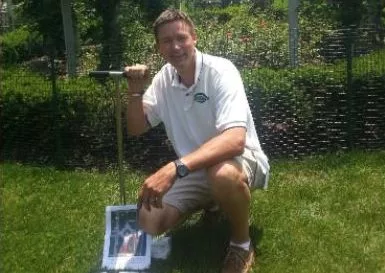In the 1970s, you would have found 12-year-old Eric Hansen pedaling his bicycle on the suburban streets of Chicago, dragging his lawnmower from lawn to lawn, earning money by mowing grass. By the time he was 16, he owned his own lawn maintenance business, had hired several of his high school friends as employees, and was socking away enough money to pay for his own college.
In 1984, Hansen went off to college, graduated, and tested a career in business finance. After seeing that he would have to start at the bottom in the financial world, he quickly opted to go back into the business he had already captained — lawn maintenance and landscaping. Hansen restarted his Chicagoland lawn care business and would eventually have as many as 35 employees that handled everything from residential accounts to commercial and municipal customers.
Discovering Southwest Michigan
Around that same time that his business was climbing in Chicago, Hansen found time to relax on the weekends in St. Joseph, Michigan. He discovered the area after visiting friends and he liked it so much he bought a weekend house that eventually because his full-time home. Hansen sold properties from his Chicago portfolio and reinvested that money in Southwest Michigan. It started with rental and lease properties, but in 2006 Hansen joined two partners to buy the Whitcomb. Hansen oversaw operations at the Whitcomb until it was sold in 2022.
Meanwhile, back in the landscaping business, interest was growing in organic lawn care solutions. As the cost of organic treatments became more affordable, Hansen saw the opportunity to start offering the additional service to his clients. His services and expertise in organics became popular and he took on major clients including several golf courses, entire residential developments, the Village of Downers Grove, and the Morton Arboretum.
In 2012, Hansen was hired by the Chicago Park District to design and consult on a 5-year program that covered using organics at Grant Park (commonly referred to as Chicago’s Front Yard), the Museum Campus (57 acres facing Lake Michigan), and just about every other public, lake-facing park district landscape that wasn’t Soldier Field.
By 2020, Hansen had gotten married, built a successful business, and put his children through college, so he decided to sell his landscape company. After the sale, he took two years off, continuing to manage his lease properties in St. Joseph, but he also found time to get his 25-ton boat captain’s license from the United States Coast Guard (Hansen said he will use that license to help people learn how to pilot their own boats, among other things).
Continuing to Grow
Not content to enter early retirement, Hansen started thinking about what he should do next, what he knew best, and what parts of it he loved the most. For him, there was one answer – turf care. That’s when he established Sunset Coast Lawns in St. Joseph.
“I enjoyed (lawn care) the most. Running a company with 35 people is tough. After two years off, I started this company with the intent of doing what I really enjoy doing – taking care of lawns. Lawn fertilization programs, core aeration, overseeding, grub and insect control – it’s not landscaping; it’s just caring for lawns,” said Hansen.
Why Organic?
A big part of his lawn care program is designed around using organics. So, why organic?
“It’s about trying to do something better for the environment, but also getting results. The way that chemical fertilizers work versus how organic materials work in the soil, it’s two different things, but they can work together,” Hansen said.
Hansen said blended products are the way to go because it bridges the gap between the customers’ immediate expectations for a lush, weed-free lawn and what organics can achieve in a couple of years.
“We can build up microbial activities in the soil, which over time will deliver better results, but it takes time. We aren’t going to be like FEDEX and deliver overnight, we can’t do that with turf. It will take a couple of years for that to happen. But some people won’t wait. So instead of going fully organic and taking two years, we start with blended products to build up the soil and still get the green turf results that consumers want, and then we start weaning off (the chemicals),” Hansen said.
“It’s an annual, seven-step program. We start with a blend and then after two or three applications, you start to see the results. We also do spot weeding and use some herbicides, but once the lawn starts growing well, it crowds out the weeds,” said Hansen. “Typically, after one season you see good results.”
Reaping What You Sow
Long term, Hansen says his program for lawn care works.
“With soil tests we can prove this. Some of the main issues you’re looking at are with phosphorus, potash, iron, and copper nutrients. You’ll see (under our program) that will gradually change. When you have a problem lawn, we can test the soil microbes and there might be something really wrong with the soil. We can make adjustments with sulfur or lime applications or additional organic materials. Once that soil starts working, you’ll see the results on top (of the lawn).”






